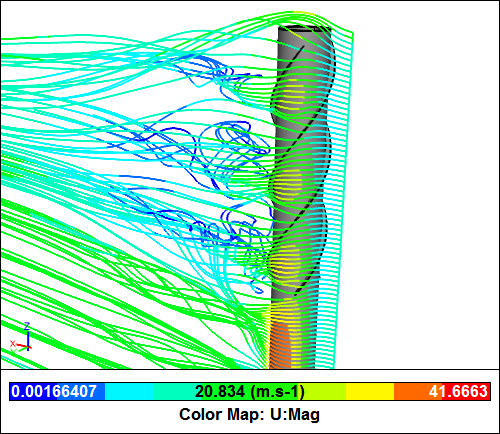
6 Things to Consider Before Switching Turbulence Model
Turbulence modeling for the Reynolds Averaged Navier-Stokes (RANS) equations - the basis of most industrial Computational Fluid Dynamics (CFD) software - is a complex field. Trying to strike a balance between accuracy and computational efficiency has given rise to a relatively large number of different turbulence models. I am not aware of a definitive list to match turbulence models to applications - if you are, please share! With this in mind I'll share 6 suggestions before you consider switching the default turbulence model in your CFD software.
 RANS CFD Simulation of Air Flow Around a ChimneyUsing the k-omega SST turbulence model
RANS CFD Simulation of Air Flow Around a ChimneyUsing the k-omega SST turbulence model
The k-omega SST turbulence model is considered to be a relatively robust, accurate, and efficient model for a wide range of applications and is the default turbulence model in Caedium. Unless you are seeing results that call this into question I would suggest you stick with the default model. Before switching to a different turbulence model first consider that poor CFD results could also be due to:
1. Poorly positioned boundaries, e.g., an outlet too close to strong velocity gradients
2. Poor mesh elements (skewed)
3. Insufficient mesh resolution in critical flow regions
4. Unconverged results
Remember that when using standard wall functions (to avoid extremely fine near wall meshes) they require y+ values to be in the range 30-300 for reliable results.
Independent of the turbulence model, you can also try the following to improve accuracy:
5. A second order difference scheme. In Caedium select your volume and set: Substance->Solver->Schemes->Divergence = Linear Upwind.
6. A universal wall function valid over a wider y+ range (i.e., 1-300) near the wall. In Caedium select your wall boundaries and set: Physics:Wall->Type:Default->nut = U Spalding Wall Function.
Note that these options can sometimes result in less robust simulation behavior.
If you know that the fluid flow is likely to be entirely laminar due to the Reynolds number (e.g., in a pipe flow with Re < 2300) then you should switch the turbulence model for the laminar model.
If after trying these suggestions you'd still like a second opinion, then I suggest you try the Realizable k-epsilon model, which is another widely used and reliable turbulence model.
Recent blog posts
- CFD Simulates Distant Past
- Background on the Caedium v6.0 Release
- Long-Necked Dinosaurs Succumb To CFD
- CFD Provides Insight Into Mystery Fossils
- Wind Turbine Design According to Insects
- Runners Discover Drafting
- Wind Tunnel and CFD Reveal Best Cycling Tuck
- Active Aerodynamics on the Lamborghini Huracán Performante
- Fluidic Logic
- Stonehenge Vortex Revealed as April Fools' Day Distortion Field

Comments
thanks for the article, what
thanks for the article,
what is the difference between kOmegaSST and RealiziableKE and when should you use either?
Differences between turbulence models
"One variant of k-omega that has gained popularity, especially in the aeronautics area, is the shear stress transport (SST) model. The model has gained this popularity based on its ability to predict separation and reattachment better when compared to k-epsilon and the standard k-omega." from Choosing the Right Turbulence Model for Your CFD Simulation